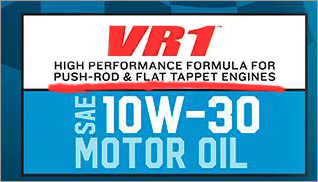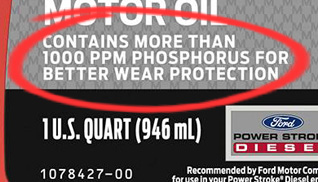From the Rock Auto Newsletter/Blog:
 "Zinc" or "Phosphorus" on an oil bottle label usually is referring to the additive zinc dialkyl dithiophosphate (ZDDP). ZDDP helps prevent wear, especially where the camshaft contacts the lifter in flat tappet lifter engines. Newer engines (since the late 1980s) have roller valve lifters and therefore do not benefit as much from ZDDP. The anti-wear benefits of ZDDP were recognized in the 1950s. The oil of the 1950s had only about 300 parts per million (ppm) ZDDP. The concentration of ZDDP in motor oil gradually increased until it reached a maximum of 1200 to 1400 ppm in the 1980s. (More than 1400 ppm of ZDDP in oil actually starts to increase engine wear.) Unfortunately, it was discovered that ZDDP makes catalytic converters for gasoline engines less effective by gradually coating the catalyst material with phosphate. To satisfy the latest API Service "SN" oil standard, oil manufacturers only put 600 to 800 ppm ZDDP in their oil. For over a decade, car enthusiasts with flat tappet lifter engines have been debating whether the 600-800 ppm ZDDP in new "SN" oil is enough protection. Oil experts say that it is enough wear protection once the engine is broken in.  The flat tappet lifter equipped engines in my family fleet were all broken in around a half century ago. I still like to dote on my old cars by giving them a little extra ZDDP as long as it does not require too much hassle or extra money. Valvoline VR1 Racing Oil has been one convenient option. It does not qualify for the "SN" rating because it has too much ZDDP and it is "not recommended for extended use in vehicles with catalytic converters." Another new, less expensive possibility may be the 10W-30 oil made for some of the most modern diesel engines. Some old car enthusiasts have long recommended oil for diesel engines because it frequently contained more ZDDP. Unfortunately, diesel oil was typically only available in a heavy weight such as 15W-40.  The label on Motorcraft's 10W-30 oil for diesels says it "contains more than 1000 ppm phosphorus for better wear protection." That is 200 to 400 more ppm at little or no additional cost compared to "SN" 10W-30 oils. The Motorcraft diesel oil label also says, "do not use in gasoline engines equipped with catalysts." I am testing the Motorcraft 10W-30 for diesels in the 351 under the hood of my 1971 Ford LTD convertible. However, I am not recommending that anyone else use oils labeled "diesel" in any gasoline engines. Please consult your vehicle's owners manual, the appropriate authorities, legal council, etc. before choosing a new type of oil for your specific engine. (For most vehicles, simply look under "Engine" and "Oil" in the RockAuto.com catalog to see manufacturer recommended choices. Oils listed by weight (10W-30, 0W-40, etc.) are found in the "Tools & Universal Parts" tab, under "Engine" and finally "Oil.") Tom Taylor, To read more of Toms articles, click this link and choose from story titles on the Newsletter Archives page. |






